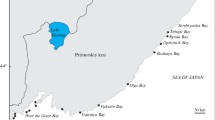Abstract
Copper in ionic form is found to be very poisonous for photosynthesis and growth of unicellular algae at concentrations of Cu usually found in natural waters. This indicates that Cu is ordinarily not present in ionic form but is complexed by organic matter such as polypeptides. The affinity of Cu to diethyl-dithiocarbaminate is very much higher than to the organic matter which complexes Cu in nature. Thus, it is not possible to distinguish the two forms of Cu during analysis. Complexed Cu is not poisonous to algae. It has recently been shown that ocean water in the centres of upwelling becomes suitable for plankton growth only after the addition of a chelator. This suggests that a large part of the Cu found in the subsurface waters of the oceans is present in ionic form. Some manufactures of C14 ampoules have used ordinary distilled water which often has a content of about 250 μg Cu/l. Thus, it is very likely that some productivity measurements have been influenced. A likely example is mentioned.
Similar content being viewed by others
Literature cited
Atkins, W. R. G.: The copper content of sea water. J. mar. biol. Ass. U.K. 18, 193–198 (1932).
Barber, R. T. and J. H. Ryther: Organic chelators: factors affecting primary production in the Cromwell Current upwelling. J. exp. mar. Biol. Ecol. 3, 191–199 (1969).
Goldberg, E. D.: The ocean as a chemical system. In: The Sea, Vol. II. pp 3–26. Ed. by M. N. Hill. London: Intersciences Publishers 1963.
Hutchinson, G. E.: A treatise on limnology, Vol. I. 1013 pp. New York: Wiley & Sons 1957.
Johnston, R.: Sea water, the natural medium of phytoplankton. I. General features. J. mar. biol. Ass. U.K. 43, (2), 427–456 (1963).
—: Sea water, the natural medium of phytoplankton. II. Trace metals and chelation and general discussion. J. mar. biol. Ass. U.K. 44 (1), 87–110 (1964).
Jørgensen, E. G.: Antibiotic substances from cells and culture solutions of unicellular algae with special reference to some chlorophyl derivatives. Physiologia Pl. 15, 530–545 (1962).
McAllister, C. D., N. Shah and J. D. H. Strickland: Marine phytoplankton photosynthesis as a function of light intensity. A comparison of methods. J. Fish. Res. Bd Can. 21 (1), 159–181 (1964).
Riley, G. A.: Significance of the Mississippi River drainage for biological conditions in the northern Gulf of Mexico. J. mar. Res. 3, 214–228 (1937).
—: Limnological studies in Connecticut. Part II. The copper cycle. Ecol. Monogr. 9, 66–94 (1939).
Rodhe, W.: Sjön Norrvikens vattenbeskaffenhet år 1946–47 och vattenblomningens bekämpande med kopparsulfat sommaren 1947. Vattenhygien 2, 38–61 (1948).
Schou, S. A.: Kobberindholdet i Destilleret Vand. Arch. Pharm. Chemi 61, 524–549 (1954).
Slowey, J. F., L. M. Jeffrey and D. W. Hood: Evidence for organic complexed copper in sea water. Nature, Lond. 124, 377–378 (1967)
Steemann Nielsen, E.: Use of radio-active carbon (C14) for measuring organic production in the sea. J. Cons. int. Explor. Mer 18, 117–140 (1952).
Steemann Nielsen, E. and L. Kamp-Nielsen: Influence of deleterious concentrations of copper on the growth of Chlorella pyrenoidosa. Physiologia Pl. 23 (1970).
—: The effect of deleterious concentrations of copper on the photosynthesis of Chlorella pyrenoidosa. Physiologia Pl. 22, 1121–1133 (1969).
Steemann Nielsen, E. and S. Wium-Andersen: The effect of deleterious concentrations of copper on the photosynthesis of Nitzschia palea. (In preparation).
Strickland, J. D. H. and T. R. Pabsons: A manual of sea water analysis. Bull. Fish. Res. Bd Can. 125, 1–185 (1969).
—: A practical handbook of seawater analysis. Bull. Fish. Res. Bd Can. 167, 1–311 (1968).
Unesco-Scor Ices Report of a meeting of the joint group of experts on radio carbon estimation of primary production. 4 p. UNESCO Tech. Pap. in mar. Sci. No. 6. 4 pp (1967).
Author information
Authors and Affiliations
Additional information
Communicated by B. Swedmark, Fiskebäckskil
Rights and permissions
About this article
Cite this article
Nielsen, E.S., Wium-Andersen, S. Copper ions as poison in the sea and in freshwater. Marine Biology 6, 93–97 (1970). https://doi.org/10.1007/BF00347237
Accepted:
Issue Date:
DOI: https://doi.org/10.1007/BF00347237




